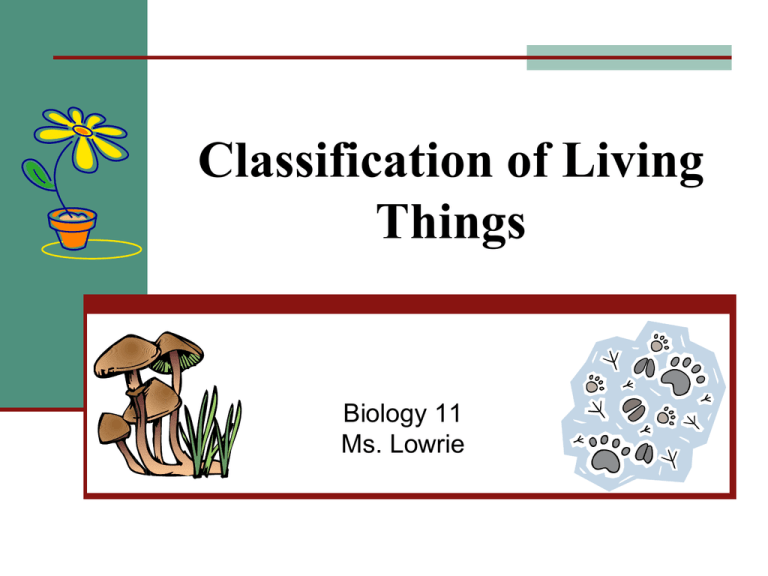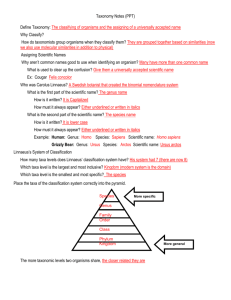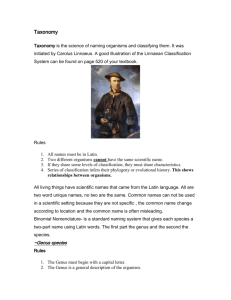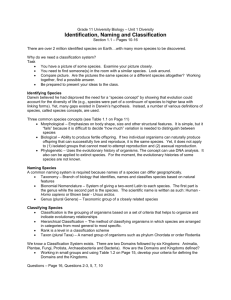Introduction - HRSBSTAFF Home Page
advertisement

Classification of Living Things Biology 11 Ms. Lowrie #1 – Most Discoveries … Why? Areas that are difficult to access Rainforest Deep ocean Only 3% explored #2 – Classification vs. Taxonomy Classification Act of grouping organism Taxonomy Science of classifying organisms #3(a) – Early Taxonomist Aristotle 384 – 322 BC Greek philosopher Classified organisms based on observations Sponge: plant or animal? #3(b) – Aristotle Arranged organisms based on: Plant Grass(small), bush(medium) or tree(big) Animal: Earth, water or air Problems: Seagull? Bacteria? #3(c) – “Scala Naturae” “Ladder of Nature” All creatures are arranged in a hierarchy of complexity Humans at top rung Then Now #4 – Modern Taxonomy a) Carolus Linnaeus 1707 – 1778 Swedish botanist b) Organisms grouped based on physical characteristics Hierarchical #4(c) – Natural Classification Closer related organisms will have more features in common #5 – Levels of Taxa a) First = Kingdom General b) Last = Species Specific Ex: leopard Taxa Analogy: Where do you live? Kingdom Continent Phylum Country Class Province Order County Family City Genus Street Species Number General Specific How to Remember the 7 Taxa 7 taxa: kingdom, phylum, class, order, family, genus, species King Philip came over for grape soda #6 – Binomial Nomenclature Scientific names Latin Made of two words: Genus 2. species Underline if written (not typed) 1. Sugar maple Acer saccharum #7 – Latin Advantage Avoids confusion When speaking different languages #7 – Latin Advantage Avoids confusion When speaking different languages #7 – Latin Advantage Avoids confusion With multiple common names What is a …? Mountain lion Cougar Puma Screaming wildcat All the same! Puma concolor (Felis …) #7 – Latin Advantage Avoids confusion When common names are misleading Jellyfish is NOT a fish! Any questions??? Task Use notes & pages 326 – 331 Answer: Practice Questions: # 1 to 5 (pg 331) #1 select one example in school and one outside Section Questions: # 1, 2, 5, 6 (pg 334) Question #5 – Page 334 a) Which of the species are most closely related? Explain. b) Is the river otter more closely related to the muskrat or weasel? Why? c) Is the groundhog more closely related to the chipmunk or ferret? Why? d) Which of the species is (are) the closest relative(s) of the squirrel? Explain. Question #6 – Page 334 a) Felis concolor b) Sorex arcticus c) Canis rufus d) Mephitis mephitis e) Alopex lagopus f) Eutamias alpinus mountain lion (vii) arctic shrew (i) red wolf (iv) skunk (iii) arctic fox (vi) alpine chipmunk (v) g) Sciurus arizonensis Arizona gray squirrel (viii) h) Sylvilagus aquaticus swamp rabbit (ii)







